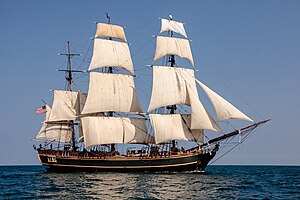This article needs additional citations for verification. (May 2020) |
 Replica of Bounty, built in 1960
| |
| History | |
|---|---|
| Name | Bethia |
| Owner | Private merchant service |
| Builder | Reputedly Blaydes Yard, Kingston-upon-Hull, England |
| Launched | 1784 |
| In service | 1784–1787 |
| Fate | Sold to the Royal Navy, 23 May 1787 |
| Name | Bounty |
| Cost | purchased for £1,950 |
| Acquired | 23 May 1787 |
| Commissioned | 16 August 1787 |
| In service | 1787–1790 |
| Fate | Burned by mutineers, 23 January 1790 |
| General characteristics | |
| Tons burthen | 22026⁄94 (bm) |
| Length | 90 ft 10 in (27.7 m) |
| Beam | 24 ft 4 in (7.4 m) |
| Depth of hold | 11 ft 4 in (3.5 m) |
| Propulsion | Sails |
| Sail plan | Full-rigged ship |
| Complement | 44 officers and men |
| Armament |
|




HMS Bounty, also known as HM Armed Vessel Bounty, was a British merchant ship that the Royal Navy purchased in 1787 for a botanical mission. The ship was sent to the South Pacific Ocean under the command of William Bligh to acquire breadfruit plants and transport them to the British West Indies. That mission was never completed owing to a 1789 mutiny led by acting lieutenant Fletcher Christian, an incident now popularly known as the Mutiny on the Bounty.[1] The mutineers later burned Bounty while she was moored at Pitcairn Island in the Southern Pacific Ocean in 1790. An American adventurer helped land several remains of Bounty in 1957.
- ^ Knight, C. (1936). Carr Laughton, Leonard George; Anderson, Roger Charles; Perrin, William Gordon (eds.). "HM Armed Vessel Bounty". The Mariner's Mirror. 22 (2). Society for Nautical Research: 183–199. doi:10.1080/00253359.1936.10657185. Archived from the original on 28 April 2023. Retrieved 23 January 2009.